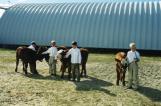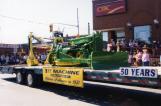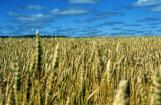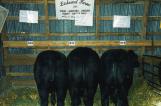14
The program fizzled out in the early 1950's as farmers began to specialize in one commodity, e.g. dairy, beef, pork, sheep, poultry and cash crops. The Radio Farm Forum couldn't meet the needs of the changing scene.16
The other area of valuable social activity in the rural community was the organization of a Junior Farmer program. It was for youth from twelve to eighteen. There were clubs organized in at least eight areas of the Temiskaming District. Each area had smaller units of specific interest clubs. There were dairy, beef, pork, sheep, poultry, potato and machinery clubs. Each club had local volunteer leaders. Both boys and girls participated where they learned gardening, baking, sewing and personal care.They competed with each other at fairs and field days. One big event was the livestock and poultry judging competitions usually held at the New Liskeard beach and the demonstration farm. There would be one hundred to one hundred and fifty young people from all over the district at these events. Local club leaders would bring in classes of livestock, poultry and grain for the boys and girls to judge and place in an order of reasons for their placements. Every youth had to judge everything and points were awarded. A grand aggregate award would be given to those who achieved the most points. Then the youth would play ball or go swimming. A supper was held in the beach pavilion, awards would be given out and everyone would join in a square dance. This provided a great learning and social experience.
The winners of the judging competitions would then be eligible to go to the provincial competitions held in Guelph at the university.
This was a great training ground for future farm leaders. For several years two young people would be chosen to attend a week long "leadership training camp" held at a resort on Lake Couchiching near Orillia.
17
Junior calf show at the FairFall 2004
New Liskeard, Ontario, Canada
 Credits:
Credits:New Liskeard Agricultural Society
18
Eventually the 4H clubs took over the youth programs and Junior Farmers became the young adult program. As farm operations got larger, the number of farm families declined. Today 4H clubs still exist but they operate on a district wide basis for each commodity. They are still dependent on volunteer local leaders.19
Programme of the First Annual Musical Festival3 June 1932
New Liskeard, Ontario, Canada
 Credits:
Credits:Temiskaming Shores Public Library Archives
20
In its "hay day", the junior Farmers program accomplished a great deal towards community living. In 1932, the Junior Farmers with the help of Mr. Cook, established a "Temiskaming Festival of Music". That festival was taken over by the Kiwanis Club and has functioned annually to this day. Two full weeks of musical evaluations, for tiny tots to adults, are still enjoyed.In the 1950's the Department of Agriculture hired an assistant agricultural representative, Garnet Mills, whose main assignment was to work with youth and young adults.
The Junior Farmers held public speaking competitions for rural youth. Winners could go on the provincial trials. They organized field days, where equipment dealers could demonstrate new haying and other equipment. They held ploughing matches and participated in fairs and field days.
21
Type of farm equipment used in the Little Claybelt, mid-century2004
New Liskeard, Ontario, Canada
 Credits:
Credits:New Liskeard Agricultural Society
22
Many of the youth from the mid-century period went on to establish their own farms and became the leaders in agriculture which was rapidly changing from horses to tractors and from hard physical work to mechanization.In the 1970's the "New Liskeard College of Agricultural Technology" was created and for two decades, was where many of the leading younger farmers of today were trained. With the government cutbacks it was closed in 1990. Since then very few young people have entered into agriculture as a career.
24
Since the first settlers let the rich soils of Temiskaming run through their fingers, agriculture has been a stabilizing influence in the economic growth of the urban communities. Logging and mining have run their course and declined.The farmers who migrated to Temiskaming were aggressive and determined people who weathered the ups and downs of farming. Of all the Districts in Northern Ontario, Temiskaming has become the leader in the production of every commodity.
25
2004 Fall Fair ParadeFall 2004
New Liskeard, Ontario, Canada
 Credits:
Credits:New Liskeard Agricultural Society
26
Beef OrganizationsWhen the early settlers moved to Temiskaming from Southern Ontario or Southern Quebec, they brought with them, whatever cattle they had. Primarily, they needed cows to provide milk for their families. The male offspring would provide meat. The settlers weren't the least bit concerned about the genetic makeup of their livestock. Dual-purpose breeds like Durhams or Red Polls were the favourites.
As commercial dairies were set up in each community, then the milking breeds were brought in - Holstein, Jersey, Guernsey, and Ayrshire.


